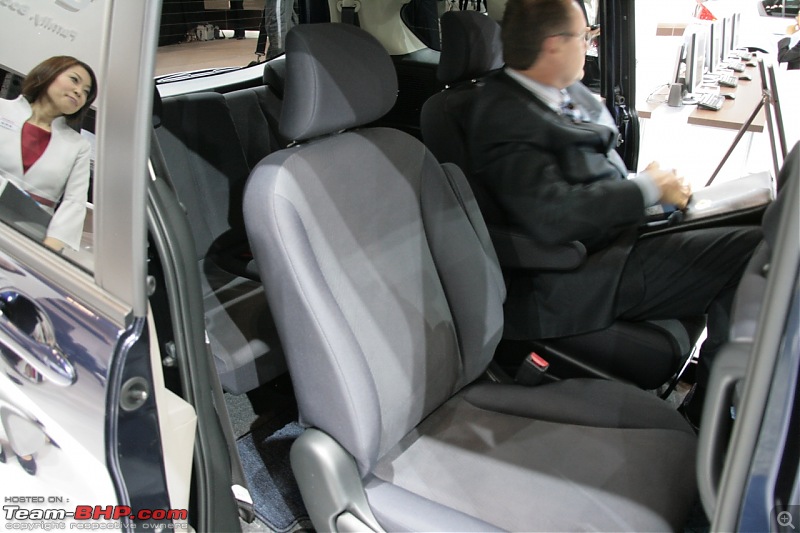| |||||||
| Search Forums |
| Advanced Search |
| Go to Page... |
 |
| Search this Thread |  19,803 views |
| | #16 |
| BHPian | Nice pictures dude -Thanks for sharing.Was there any pics of any SUVs? |
| |  ()
Thanks ()
Thanks
 |
| |
| | #19 | |
| BANNED Join Date: Jun 2009 Location: Gudaibiya; BAHRAIN/ Vandiperiyar; KERALA/ Wuhan; CHINA
Posts: 359
Thanked: 6 Times
| Mitsubishi Concept PX-MiEV Quote:
 PRESS RELEASE: Concept: The new Mitsubishi Plug-in Hybrid System brings a major increase in range and environmental performance The MITSUBISHI Concept PX-MiEV is a concept for a new-generation plug-in hybrid crossover that delivers both outstanding environmental and road performance. Extending the active range of the i-MiEV city car, this concept also satisfies the need for mobility that combines occupant comfort with powerful performance. The MITSUBISHI Concept PX-MiEV is powered by the all-new Mitsubishi Plug-in Hybrid System which is designed primarily to drive the vehicle in all-electric mode while using a gasoline engine to generate electricity and to assist the electric motors as and when required. Depending on the energy remaining in the drive battery and on driving conditions, the system automatically switches between three drive modes: all-electric EV, on-the-move generating EV, and Motor + Engine. The system allows the MITSUBISHI Concept PX-MiEV to return super-low fuel consumption figures. The concept is fitted with Mitsubishi's new S-AWC (Super All Wheel Control) advanced vehicle handling control system that is built around torque and braking control at each wheel and incorporates electronically-controlled E-AYC (Electric-powered Active Yaw Control) which uses a differential motor to control rear wheel torque split. Among the many features that makes this concept car the crystallization of Mitsubishi Motors' wealth of automotive environmental technology is the cocochi-interior which embraces occupants in a very comfortable and healthy cabin environment. Providing very high levels of both environmental performance and economy, the MITSUBISHI Concept PX-MiEV stands apart from conventional hybrids that rely mainly on engine power as it significantly extends the possibilities offered by the EV.  Exterior Design Pared-down looks give the new plug-in hybrid a simple and clean shape, producing refined looks expressing Mitsubishi Motors' new crossover design Solid, Safety, and Simple were the keywords that drove the development of the MITSUBISHI Concept PX-MiEV 's exterior design. The design team has created a clean and simple appearance for a new-generation crossover that visually sets it apart from conventional SUVs. The use of flush surfaces for the whole body eliminates virtually all projections to create a neatly-integrated one-piece design and at the same time lowers the impact to pedestrians in the event of a collision.  The front end locates the headlamps, air intakes and other functional parts within the graphics that center on the 3-diamond Mitsubishi logo in the middle of the grille to produce a simple but distinctive appearance. Styled to harmonize with the emblem, the front grille displays the advanced and high-tech qualities of the vehicle as well as presenting Mitsubishi Motors new crossover design identity. The rear end styling is also designed around the 3-diamond emblem and distinguished by graphics that encompass the full perimeter of the tailgate, giving the car a distinct personality while also projecting high-tech looks. 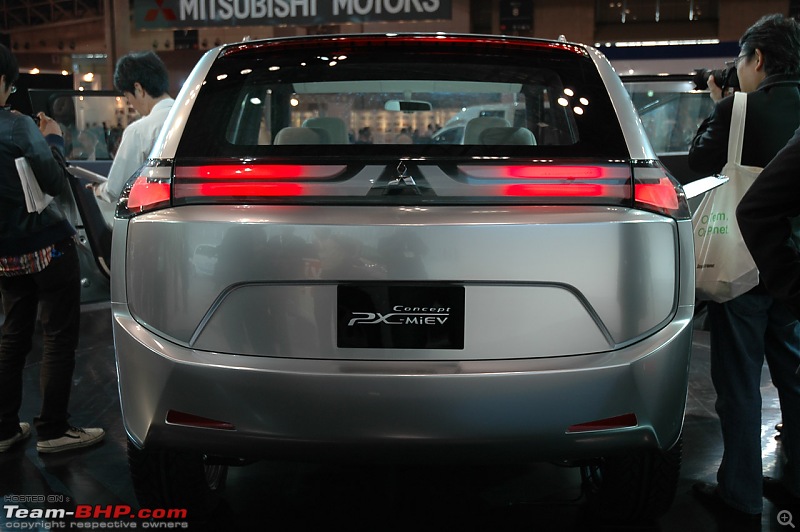 The LED headlamp and rear combination lamp units not only accent the advanced looks of the car but also improve its environmental performance through lower power consumption, longer service life and the elimination of the use of any mercury. Technical development of the headlamp LED emitters means they now project a highly visible beam that is very close to neutral white in color. The fast-illuminating brake light LED units contribute to enhanced safety performance. The body uses new high-tech coloring that brings out a distinctive metal-like look. Combining elements of both spoke and dish styling, the geometric road wheel design highlights the sense of newness and at the same time optimizes air flow over the brakes to improve heat dissipation as well as improving aerodynamic characteristics at higher vehicle speeds.  Interior Design Ergonomic, simple, classy design gives cabin soft wraparound appearance The interior uses high-grade nubuck leather lining throughout and a high-contrast rich purple/off-white two-tone color scheme to create a comfortable space that melds choice quality with sophisticated and advanced design. The wraparound design of the cockpit and the excellent location and hold provided by the seats help the driver to concentrate on operating his vehicle. The use of a number of comfort items in this classy and functional space allows occupants to enjoy a sense of well-being similar to that found in the first-class cabin of an aircraft. Soft illumination for the center console monitor and door trim creates a serene ambience while generating a high-tech look. The illumination flashes on/off when the drive battery is being charged to create an atmosphere that aesthetically befits a plug-in hybrid. The grouping of the power window, interior door handle and other switches in a single touch panel has reduced the number of individual parts in the interior and contributes to its clean and uncluttered layout. In terms of environmental performance, an Eco-Drive selector switch on the center console that conserves engine output, transmission and air conditioning power consumption together with an indicator in the instrument monitor that displays Eco-Drive status and effectiveness help the driver to minimize energy consumption. Other environmentally-friendly features include the use of Mitsubishi Motors' own "Green Plastic" plant-derived resin technology in various items of interior trim throughout the cabin.  Mitsubishi Plug-in Hybrid System Selection of drive modes delivers smooth and comfortable performance over all kinds of roads The new Mitsubishi Plug-in Hybrid System that powers the MITSUBISHI Concept PX-MiEV maximizes the strengths of the EV: zero drive-time CO2 emissions*, powerful road performance with the gutsy torque inherent to an electric motor, and very quiet operation. The new system also incorporates a high combustion efficiency 1.6-liter MIVEC gasoline engine that is used either to turn a generator and supply the motors directly with current or charge the car's lithium-ion drive battery or, at higher vehicle speeds, to augment the motive power supplied by the motors. The result is a major increase in cruising range. The Mitsubishi Plug-in Hybrid System features Mitsubishi Motors' new MiEV OS (MiEV Operating System) that constantly monitors the charge and discharge of electrical power depending on driving conditions and the remaining energy in drive battery and selects the optimum drive mode through integrated control of the EV components and the gasoline engine. Minimizing power consumption, the system delivers road performance that is comfortable, safe and reassuring at the same time. At low to middle vehicle speeds the MITSUBISHI Concept PX-MiEV runs in all-electric mode with the drive battery supplying current to its motor(s). When the remaining energy in the drive battery falls the system switches to series hybrid mode, automatically starting the gasoline engine to turn a generator that supplies the motor(s) with electrical power. At higher vehicle speeds the system switches over to parallel hybrid mode adding the gasoline engine with its higher combustion efficiency at high revolutions to provide more motive power to the wheels. This means that depending on circumstances, at higher vehicle speeds the system can add motive power to the motors, increasing road performance. When decelerating, the system switches over to regenerative mode, using the motors as generators to charge to drive battery. In these ways, the Mitsubishi Plug-in Hybrid System switches between three drive modes depending on driving conditions and remaining energy in the drive battery: all-electric EV mode; on-the-move generating EV mode; and Motor + Engine mode. The system also incorporates the ECO mode found in the i-MiEV production model that reduces motor output and increases the amount of kinetic energy reclaimed when decelerating to provide low-consumption and environment-friendly performance. In ECO mode the system also controls the operation of the air conditioner compressor to minimize the vehicle's overall power consumption. *: CO2 emitted during the generation-to-charging process is excluded.  EV mode At low to middle vehicle speeds the vehicle operates in all-electric mode with current from the drive battery turning the front motor which rotates the front wheels. When driving on snow, in the rain or in other low surface friction situations where maximum vehicle stability is required, the system automatically switches to 4WD by feeding power to the rear wheel motor as well when sensors detect any wheel slip. Series hybrid mode When the remaining energy in the drive battery falls the system automatically switches to series hybrid mode and starts the gasoline engine to power the generator and use the electricity generated to turn the motor. As in EV mode, the system switches to 4WD when circumstances so require. Parallel hybrid mode At higher vehicle speeds the gasoline engine, with its high efficiency at high revolutions, supplies additional motive power to assist the front motor. When the driver makes sudden lane changes or other maneuvers requiring maximum vehicle stability the system switches to 4WD by bringing in the rear motor to drive the rear wheels. When overtaking at higher speeds or in other situations requiring faster acceleration the system uses both the front and rear motors and the gasoline engine to supply motive power. Regenerative mode on deceleration When the vehicle is slowing or descending a long slope and the driver has his/her foot off the accelerator the system switches to the regenerative mode in which the front and rear motors serve as generators driven by the kinetic energy reclaimed from the drive train, converting it to electricity which is then stored in the drive battery. 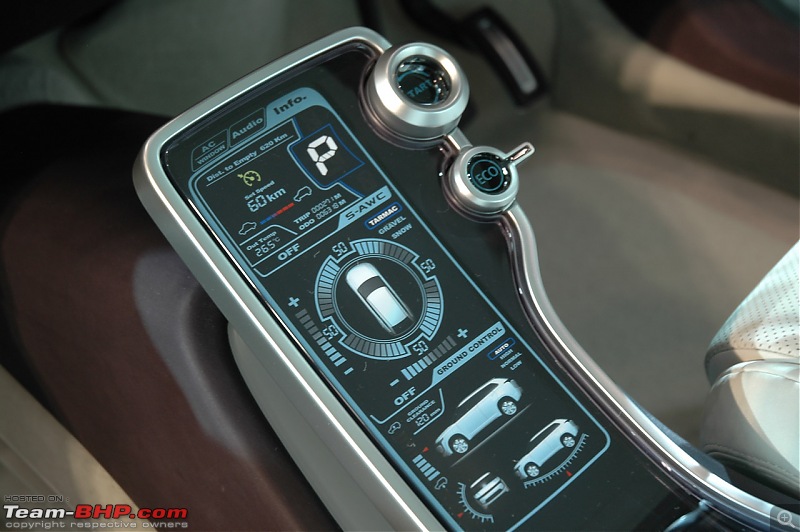 Charging mode As with the i-MiEV production model, the MITSUBISHI Concept PX-MiEV features a 3-way battery charging system that uses either a 100-volt or 200-volt domestic supply or a high power quick-charging station. The system also incorporates a Wireless Charging Program feature that allows the owner to start charging the battery or start the air conditioner at a preset time even when away from the vehicle. Normal charging: In normal charging, the driver simply connects the charger cable to a standard domestic outlet and then to the socket on the vehicle. The charging process starts and stops automatically. An on-board charger converts the domestic supply voltage to the voltage required to charge the battery. Quick charging: For quick-charging when away from home, the driver plugs the vehicle into a quick-charging station provided at shopping centers and other facilities into the quick-charge connector on the vehicle. Charging takes about 30 minutes and stops automatically when the battery reaches 80% of full charge. Wireless Charging Program Feature: The system incorporates a Wireless Charging Program feature that allows the owner to start charging the drive battery or start the air conditioner at a preset time even when away from the vehicle using a two-way remote controller. Charging timer: The owner can preset the time for charging to start, allowing him/her to make use of times when electricity rates are cheaper (i.e. night time, depending on power company rates). Preset air conditioning: The driver can preset the time the air conditioning is activated so that the car interior is at a comfortable temperature before entering the car. Power supply mode The MITSUBISHI Concept PX-MiEV also subscribes to the "Smart Grid" concept that calls for maximizing the effective use of electrical power and which is currently attracting attention in the fight to combat global warming. When the vehicle is stationary, the electrical energy stored overnight in the MITSUBISHI Concept PX-MiEV 's drive battery can be used to power electric home appliances during the day when domestic electricity consumption is highest by connecting them to the charging socket on the car. The battery power can also be used as an emergency power source in the event of a natural disaster and the system will start the engine to generate electricity when the energy remaining in the battery drops. The 100-volt AC auxiliary socket in the rear luggage compartment also allows the drive battery to be used for a variety of non-vehicle uses including powering cooking or lighting equipment and other appliances when camping or engaged in other leisure activities.  S-AWC (Super All Wheel Control) The MITSUBISHI Concept PX-MiEV uses Mitsubishi Motors' proprietary S-AWC advanced vehicle handling control system that regulates torque and braking at each wheel individually to deliver on-demand handling and outstanding vehicle stability. S-AWC exercises integrated control over the following system components: ASC (Active Stability Control) and ABS (Anti-lock Brake System); E-4WD (Electric-powered 4WD) which electronically controls front and rear motor output; and E-AYC (Electric-powered Active Yaw Control) which electronically controls rear wheel torque split at the rear wheels. Like the AYC system on the Lancer Evolution X, when required by driving conditions E-AYC controls traction and vehicle stability by generating a torque difference between the left and right wheels. However, while AYC employs a wet multi-plate clutch arrangement to transfer drive torque between the wheels and generate a torque differential, E-AYC uses a differential motor located between the rear wheel drive axles. The use of a differential motor provides a high-efficiency, high-response system that reduces torque transfer losses and that can reclaim energy. E-AYC control modes Controlling understeer: When the S-AWC system detects that the car is understeering, the E-AYC differential motor increases the speed difference (revolutions) between the inner and outer wheels and transfers torque from the inner wheel to the outer wheel. The resulting change in torque difference generates a split-second reverse wheel rotation, controlling understeer. Controlling oversteer: When the S-AWC system detects that the car is oversteering, the E-AYC differential motor reduces the speed difference (revolutions) between the inner and outer wheels and transfers torque from the outer to the inner wheel. The resulting change in torque difference generates a split-second reverse wheel rotation, controlling oversteer. When it operates in this way the rotational speed of the differential motor slows, allowing torque energy to be converted to electrical energy and reclaimed by the battery. Electronically-controlled air suspension 3 ride heights maximize vehicle stability over poor surfaces and at higher speeds and improve access to the vehicle At the turn of a switch the driver can select from three ride height modes, allowing him/her to choose the optimumheight for road surface and other driving conditions and thereby maximize vehicle stability and facilitate access to and from the vehicle. Auto (normal ride height) Auto height adjustment maintains the ride height at a fixed level regardless of the number of occupants or amount of luggage carried to deliver a comfortable ride and optimum vehicle stability on the road. At higher vehicle speeds the system automatically lowers the ride height to improve aerodynamic performance and vehicle stability. High Selecting the High setting raises the ride height of the car and provides additional vehicle clearance over poor road surfaces. As vehicle speed increases ride height is lowered automatically to the Auto height. Low When the vehicle is stationary the driver can select the Low setting to lower the ride height and facilitate passenger access to and from the car and also loading and unloading of luggage. If the driver starts off with Low selected, the ride height will automatically be raised to the Auto height as vehicle speed increases. Comfort / Interior Environment Proposal for fun and pleasantly comfortable interior space The MITSUBISHI Concept PX-MiEV provides an interior space that is friendly to both occupants and the environment and that, with special attention to operability and visibility, can satisfy anyone with its comfort and driving pleasure. cocochi-interior : new technologies package Clean, Stress-free, Safe & Reassuring Mitsubishi Motors has been introducing in its production cars the cocochi-interior which embraces occupants in a pleasantly comfortable cabin environment developed to a "Clean, Stress-free and Safe & Reassuring" theme. The MITSUBISHI Concept PX-MiEV adds to the cocochi-interior technologies already found in some of its production models a number of new technologies still under development to provide a cabin environment that is as healthy as it is comfortable. Clean Upholstery deactivates allergens, breaks down VOCs and offensive odor molecules, sterilizes bacteria The MITSUBISHI Concept PX-MiEV uses seat upholstery that incorporates an antiallergen agent and a visible-light photocatalyst. The application of an antiallergen coating to the upholstery deactivates the allergenic activity of ticks, pollen and other allergens and prevents allergic reactions caused when these agents come into contact with the skin or enter the body. The visible-light photocatalyst is activated simply by visible light even while the vehicle is fitted with UV blocking window glass and is therefore able to promote the action of visible light in actively breaking down and decomposing harmful volatile organic compounds (VOCs) and offensive odor molecules and in sterilizing bacteria. Cabin heat load reduction Total vehicle heat management improves AC energy efficiency To reduce the heat load entering the car from outside, the MITSUBISHI Concept PX-MiEV uses a heat reflecting windshield and infrared blocking glass in the door windows. The body coloring also uses paint with high heat reflective properties. Inside the vehicle, heat insulation of the head lining has been upgraded, the four seats are individually air conditioned and cabin humidity is regulated. The adoption of these heat load reducing technologies allows efficient climate control while reducing power consumption to the absolute minimum in realizing a very comfortable occupant space. Heat reflecting glass reduces build up of cabin temperature The windshield uses glass with an external coating of metal oxides and with an organic laminate interlayer. This provides a significant reduction in the amount of heat energy transmitted into the cabin because the radiant heat caused by the rise in the temperature of the glass is lower than for conventional heat absorbing glass. Restricting the rise in cabin temperature reduces power consumption because less use of the air conditioning is required. The heat reflecting glass meets the CARB (California Air Resources Board) Cool Car standards due to be enforced in 2012. Individually air-conditioned seats Under each seat is a fan that directs a flow of air to the neck, back and rear of the thighs to effectively enhance occupant comfort. Sending dehumidified air over the human skin directly affects the person's sense of temperature and allows the air conditioner level to be lowered, thus saving power while achieving optimal occupant comfort. Each seat fan can be individually controlled to suit occupant preference.  Advanced Technologies Switch and control operability/viewability enhancing technologies Ergonomic design for maximum safety, peace of mind and smooth operation Mitsubishi Motors continues its research into switch and control operability and viewability along ergonomic lines. The MITSUBISHI Concept PX-MiEV uses a new-generation steering wheel-mounted switch and control layout that offers outstanding usability and viewability. Some audio, navigation, and climate control switches are grouped together on the steering wheel while switch status indicators are located in the instrument cluster where they require very little eye movement to be seen by the driver. With the switches and controls positioned so that the driver can operate them without having to take a hand off the wheel, the new layout provides outstanding operability and viewability for greater safety, peace of mind and comfort. Driver Monitoring System Linking man and car interactively for better safety, greater peace of mind Mitsubishi Motors is actively seeking to make its cars safer and less stressful to drive by linking driver and car in an interactive manner. One example of this research is the Driver Monitoring System in which a camera mounted in front of and facing the driver monitors his/her eye movements to determine his/her level of concentration while driving. If the system detects a decrease in their concentration it issues not only audible but visual and vibrational warnings and also emits a distinctive fragrance to alert him/her to the situation. New Multi-around Monitor Camera images of vehicle perimeter give driver all-round vision The Multi-around Monitor superimposes images taken by cameras located at both front end corners, on both sides and at the rear of the vehicle to produce a bird's eye view of the area surrounding the car. This is displayed on the monitor and allows the driver to check the full vehicle perimeter. In a world-first, the nose-view camera, which covers a field of 190 degrees with a single lens, now uses image processing to provide the ability to detect approaching objects. At intersections and other points where visibility is restricted, the system operates to detect approaching cars and bicycles from either side and warns the driver of their presence by highlighting them on the monitor screen and sounding an audible alert. Vehicle-infrastructure driving safety support systems DSSS (Level II) and ASV4 information exchange support systems The MITSUBISHI Concept PX-MiEV is equipped for the Driving Safety Support System (DSSS) currently being promoted by the Japanese National Police Agency. In this advanced vehicle-infrastructure communications system an on-board receiver picks up signals transmitted by roadside optical beacons and the system urges the driver to take extra care when other vehicles or pedestrians have been detected by roadside sensors and cameras at intersections and pedestrian crossings. Employing a system that uses vehicle-to-vehicle wireless technology to ascertain the position of other vehicles and warn the driver when their proximity so requires, the MITSUBISHI Concept PX-MiEV also supports the Advanced Safety Vehicle 4 (ASV4) project being promoted by the Road Transport Bureau of the Japanese Ministry of Land, Infrastructure, Transport and Tourism. The system boosts the driver's awareness of an approaching object by displaying images from the nose-view camera as well as a simplified image of the object. DSRC capability New intelligent transportation system employs ETC wireless channel The MITSUBISHI Concept PX-MiEV is fitted with a Dedicated Short Range Communications (DSRC*) system and employs the road-to-vehicle communications capabilities used in Electronic Toll Collection (ETC) to determine the position of the vehicle and whether it is parked or not. This system can be configured to sound an alarm if the vehicle is being or has been stolen. Research is currently ongoing to equip the system for automatic payment of charges for using quick-charging facilities. *: 5.8 GHz band two-way wireless communication channels specifically designed for automotive use. Reinforced Crash Safety Body Steadfast safety technology that provides peace of mind The MITSUBISHI Concept PX-MiEV uses the same structural modifications for protecting the drive battery system as the i-MiEV production model. Using Mitsubishi Motors' own RISE (Reinforced Impact Safety Evolution) crash safety body, the drive battery pack and the rest of the high-voltage components are mounted under the floor and inside the body frame. The specially strengthened battery pack is further protected by a special cross member that also improves multidirectional impact protection for reassuring crashworthiness. Safety is also enhanced by a high-voltage circuit breaker which immediately interrupts the drive battery and other high-voltage circuits when a deceleration sensor detects an impact. | |
| |  ()
Thanks ()
Thanks
 |
| | #20 |
| BANNED Join Date: Jun 2009 Location: Gudaibiya; BAHRAIN/ Vandiperiyar; KERALA/ Wuhan; CHINA
Posts: 359
Thanked: 6 Times
| Subaru WRX STi Carbon  KEY POINTS: - only for the Japanese market - 2 engine options: 2.5-liter turbo with 296 horsepower, and a more powerful 2.0-liter turbo with 305 hp -no manual transmission; only a 5 speed automatic    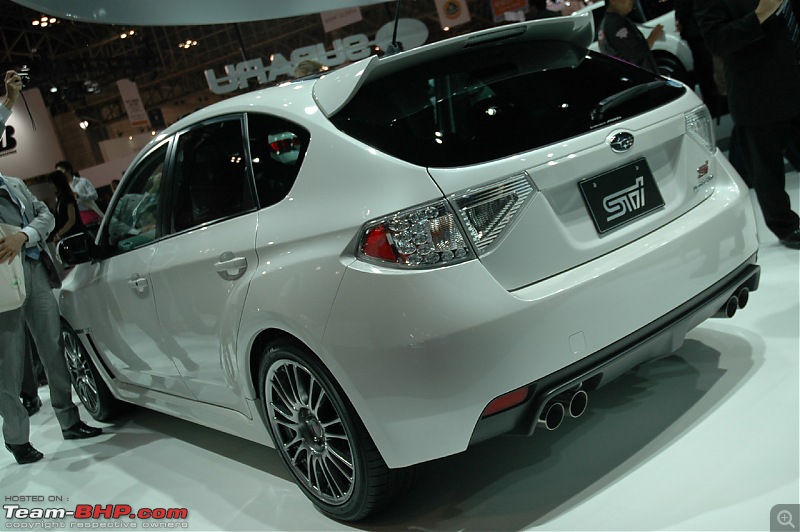      |
| |  ()
Thanks ()
Thanks
 |
| | #21 |
| BANNED Join Date: Jun 2009 Location: Gudaibiya; BAHRAIN/ Vandiperiyar; KERALA/ Wuhan; CHINA
Posts: 359
Thanked: 6 Times
|  PRESS RELEASE New Nissan Fuga blends class-leading technology, interior comfort and performance Redefining the traditional luxury car, Nissan's first generation Fuga luxury sedan, delivered outstanding performance, comfort and interior quality. Inheriting that flagship DNA package, the all-new Nissan Fuga arrives in Japanese showrooms this autumn. Class-leading performance, handling and engineering At the heart of the new Nissan Fuga are new technological advances that combine seemingly conflicting attributes such as nimble handling and comfortable ride, plus powerful acceleration and silent, eco-friendly performance. Customers may choose from either the VQ37VHR 3.7-liter V6 or the VQ25HR 2.5-liter V6.  Amongst the innovation, fitted to the Fuga are newly developed `Double Piston Shock Absorbers' (frequency responsive) that employ a double piston construction to improves handling and ride quality by increasing oil flow inside the shock absorber to reduce vibration from road undulations and absorb minor road imperfections. Incorporating some significant advanced technologies such as LDP (Lane Departure Prevention system) and Intelligent Cruise Control, this sedan promotes safe, comfortable driving. Based on sat-nav map information indicating a curve approaching, the system assists deceleration by deploying a movable accelerator pedal and activating the brakes in a system called `Intelligent Pedal (Navigation-Cooperative).' `Cornering Stability Assist' applies the VDC System to control vehicle movement for safe and smooth cornering. Both the `Intelligent Pedal' and the `Cornering Stability Assist' are world-first technologies to be featured on the new Fuga. Along with advanced active four-wheel steering, these technologies support the driver to ensure a comfortable driving.  Supporting Eco-drive and Safety-drive The new Fuga is the world-first model to feature a driving safety support system, which utilizes the ITS (Intelligent Transport Systems) in its navigation system. The system supports safe driving by providing information to alert the driver at blind intersections for example, based on information on nearby vehicles and traffic environment, which is transmitted to the Fuga from optical beacons installed all across the country. Fitted as equipment that supports eco-driving, the Fuga employs a world-first `ECO-pedal'. When the eco-pedal system is on, each time the driver steps on the accelerator, a counter push-back control mechanism is activated if the system detects overly zealous throttle work, helping to inform the driver that they could be using more fuel than required. An eco-driving indicator integrated into the instrument panel feeds the driver with real-time fuel consumption levels to help improve their driving behavior.  A first for Nissan, the newly engineered "Drive Mode Selector" is fitted as standard equipment and adjusts engine response, transmission shift schedule and 4-wheel active steering, giving the Fuga a sportier, more comfortable on-road feel. In addition to normal drive mode, the 4-door sedan features a newly fitted sports mode and eco-mode. By selecting a mode using a dial located under the gear shifter, drivers can choose modes ranging from sharper, more responsive handling to economical, easy cruising settings to suit any mood or road conditions.  Dynamic design appeals to senses The new Fuga's powerful combination of long hood, short overhangs and deeply sculpted fenders with large diameter 20-inch wheels*, give a visual appeal as only authentic rear-wheel drive sports sedan proportions can. By moving the front pillar back, lowering the car's height and adding to its width, interior comfort has been enhanced while achieving a low, powerful stance. 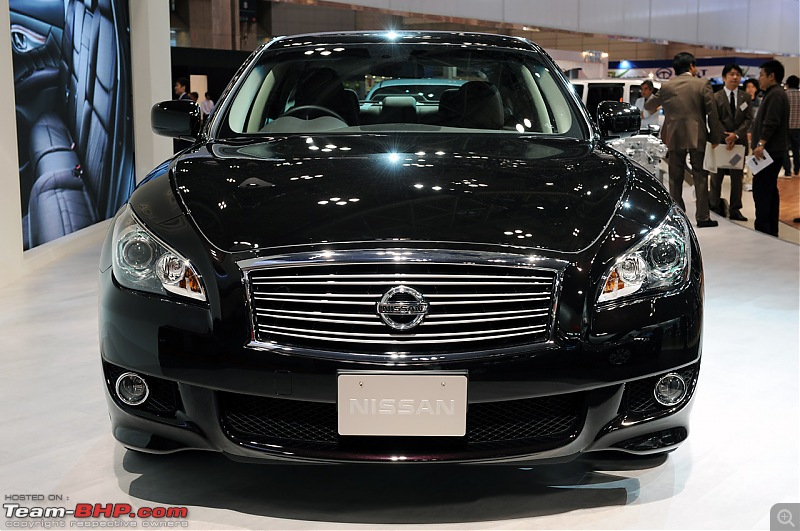 The Nissan Fuga's large, low-slung, grille and bold headlight design inspired by traditional Japanese Kabuki eye make-up combine to establish a strong presence, while its sculptured body takes on varied personalities depending on the angle viewed and the light reflected on its surface. Spacious, bright and comfortable interior The premium quality interior in the new Fuga takes the first generation's highly rated cabin design to the next level. Designers have further improved interior quality by enhancing trim and details.  For example, seats in the luxurious interior employ `premium semi-aniline leather.' A special kneading process creates a softer, more supple surface that has been finished in a strong yet soft protective coating. This process results in a luxury sofa-like leather seat that is soft to the touch yet firm in its cushion support. In addition, soft and smooth textured trim (Sofiless) has been used to cover the armrests and other spots where the skin touches, and the dashboard has been covered with a material that has the high-quality finish and comfortable softness of a leather furniture.  Employing a traditional hand-application method, craftsmen have painstakingly applied pure silver powder to the premium interior woodgrain panels giving them an immaculate mirror finish. The silver powder woodgrain paneling and semi-aniline leather are exclusive to premium interiors. Utilizing materials suitable to each specific location in the car, occupants sense they are cocooned in a tailor-made cabin, surrounded by surfaces that are soft to the touch and switches that are all newly designed and boast a more luxurious, tactile and high-quality feel. Significant luxurious appointments further elevate the Nissan Fuga's status as a leading luxury sedan. These include a world-first climate control system called ` Forest AC' that manages air temperature and fan strength, as well as humidity, odor detection and suppression to create the clean interior environment. Occupants can also enjoy the relaxing effect of special aromas and natural outdoor-like breezes through air vents, while a newly developed plasma-cluster ion unit purifies cabin air. In addition, the overwhelming sound from the BoseR Surround Sound System, which drives 16 speakers with a 14-channel digital amplifier, will ensure premium sound quality.  SPECIFICATIONS Overall Length (mm) 4,945 Overall Width (mm) 1,845 Overall Height (mm) 1,500 Wheelbase (mm) 2,900 Seating Capacity 5 Fuga Hybrid On the Nissan stand at the 2009 Tokyo Motor Show, a hybrid version of the new Fuga will also be displayed. Employing a 3.5-liter V6, high-power Li-ion batteries and a highly efficient one-motor-two-clutch parallel hybrid system solely developed by Nissan, this model generates the fuel consumption of a compact C-segment car. This model will be launched in the Japanese market from 2010 autumn.  Last edited by Bumblebee86 : 25th October 2009 at 06:07. |
| |  ()
Thanks ()
Thanks
 |
| | #22 |
| BANNED Join Date: Jun 2009 Location: Gudaibiya; BAHRAIN/ Vandiperiyar; KERALA/ Wuhan; CHINA
Posts: 359
Thanked: 6 Times
| Honda Freed |
| |  ()
Thanks ()
Thanks
 |
| | #23 |
| Newbie Join Date: Jun 2006 Location: Tokyo
Posts: 17
Thanked: 3 Times
| 2009 Tokyo Motor show - some more pics This year was my 4th year of visiting the Tokyo motor show. One event that I keenly watch the calendar for. Visited yesterday, the first day open for the public. It was quite a cloudy day but still went ahead taking family too. Unlike the previous years, the number of participants was diminished less. The RRs, Jags etc were missing. The American cars were no where see. More prominent was the ECO theme. Every manufacturer pitched in quite stongly here. There was a huge area for toys too something not seen earlier. A good enough space was taken up to showcase the CAR OF THE YEAR for the past 30 years. This included the Suzuki Alto aka India's first Maruti 800. Brought back old memories to see a piece almost new at the show. The motorcycle section too was peppered with the usual ones, with the scooters more than the previous times. Some additional pics to what Bumblebee86 has already posted. Welcome to Tokyo Motor Show 2009  An aerial view of the show  The 3 musketeers from Caterham    The Mazda RX 500   Lotus ELISE and STEALTH    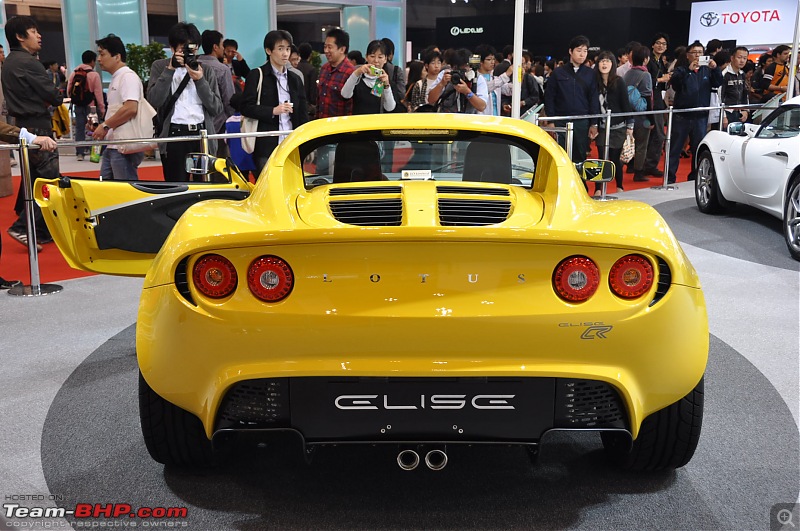  Pedestrian safety with airbags - concept   Bored of the same seat colors??? - Change it anytime, - cool concept.   A 3 seater Capsule EV from JARA (Japan Automotive Research Association)   JARA's testing track. Does our ARAI too look like this?  Crash test dummies - Then and Now 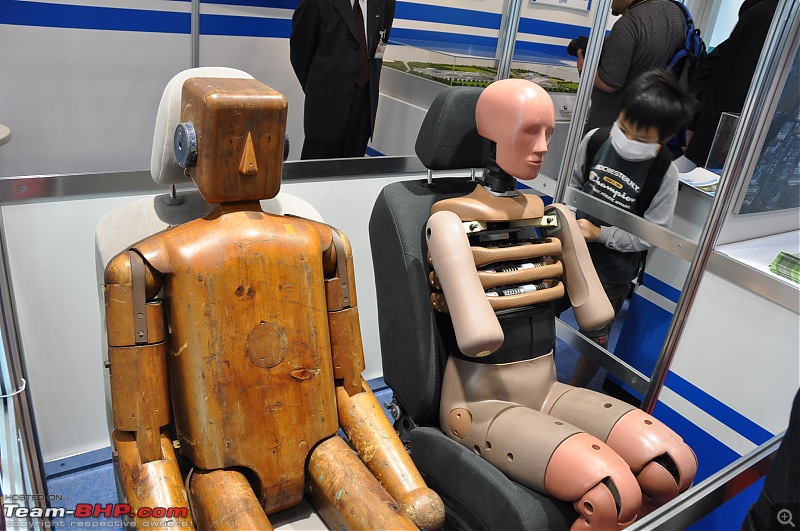  Lotus Evora  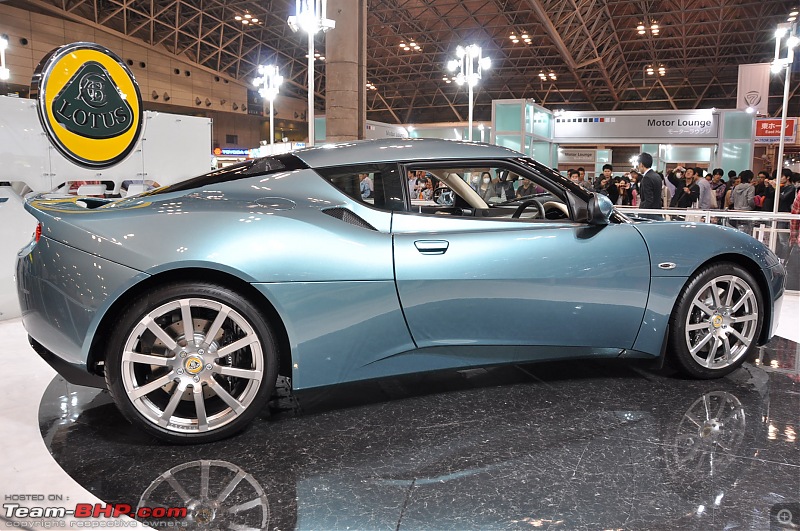 Somehow I like the shape of the back in Lotus models than the front.  PIRELLI had some hot stuff in their stalls.  But people seem to be interested behind the hot girl why????  PIRALLI had more attractive stuff - A Lamborghini in their stall, but sadly no one bothered to see the PIRALLI board on this beauty.  The Closest I have come to a Lamborghini. Yes I touched it.    Wonder which vehicle uses such a big tyre? I tried but could not come up with any guesses.  |
| |  ()
Thanks ()
Thanks
 |
| | #24 |
| Newbie Join Date: Jun 2006 Location: Tokyo
Posts: 17
Thanked: 3 Times
| The Toyota FT-86 concept    Lexus LF-CH concept  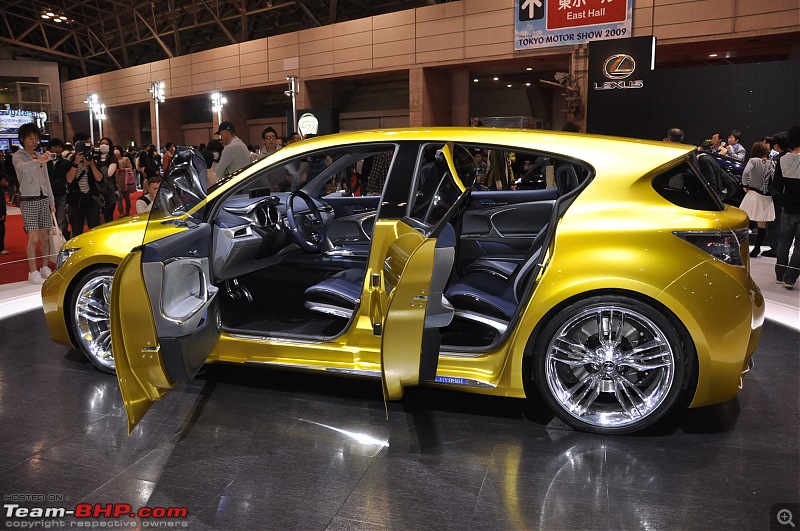  Lexus LFA concept  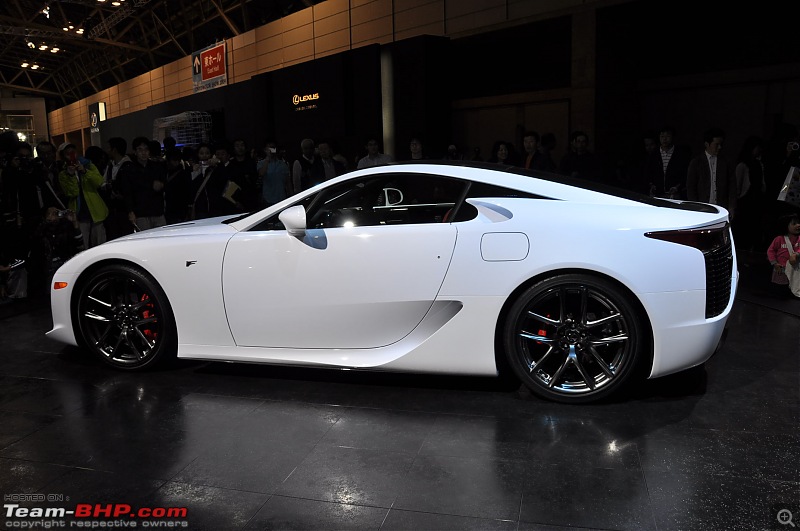  The V10 engine powering the LFA  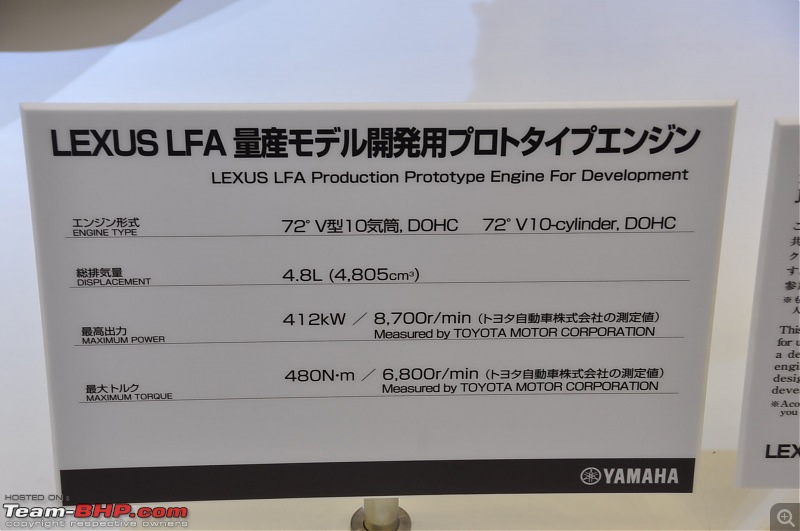 Lexus in plastic  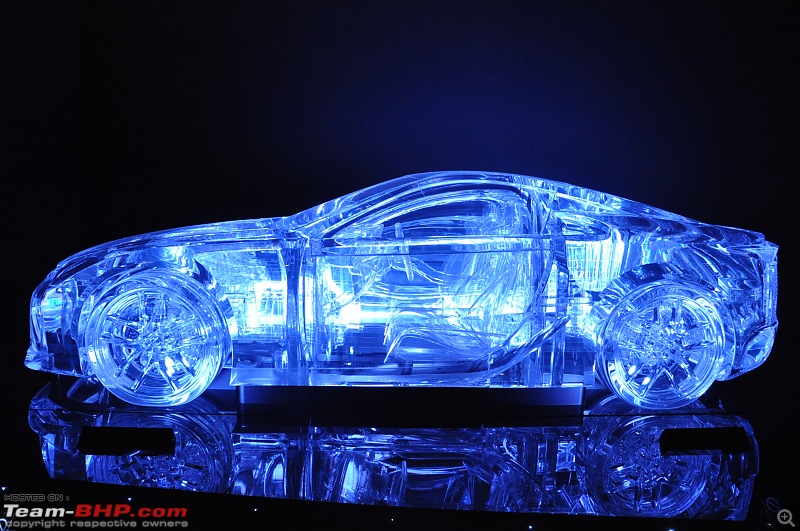   A very colorful display of Toyota IQ   The FT EV II (Future Toyata Electric Vehicle II)   Subaru Hybrid Tourer Concept   The future power of cars - aptly shown by Subaru  ASIMO - the famous humanlike robot from Honda also took part in Honda's shows. Its movements and balance were simply amazing.  Honda's new "Personal Mobility" an electric device. Looks like an Unicyle but has no pedals. Direction change front, back or sideways is just by leaning to which ever way you would like to move. Speed is less than 6km/hour and weighs less than 10kg including the Li-ion battery which runs for a hour on a full charge.   |
| |  ()
Thanks ()
Thanks
 |
| | #25 |
| Senior - BHPian | Missed this thread. Loads of great photos. Good job Bumblebee and fanataboyus  Photo Gallery | TOKYO MOTOR SHOW WEB SITE Last edited by jkdas : 26th October 2009 at 10:03. |
| |  ()
Thanks ()
Thanks
 |
 |








